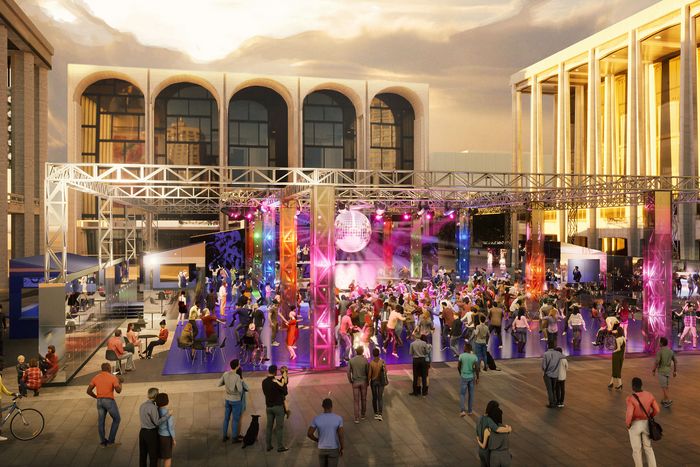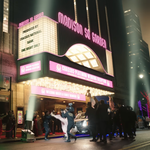
For the first months of the pandemic, Lincoln Center lay fallow, its halls locked, its outdoor areas fenced off like a radioactive zone. If the grand fountained plaza didn’t look as eerily abandoned as, say, Times Square, that’s because even in ordinary, pre-contagion times, it was only sporadically lively, mostly in the minutes before curtain time. After a few tentative attempts to reopen during the pauses between waves, Lincoln Center finally roared back to life outdoors a year ago with Restart Stages, which commandeered its outdoor public areas for a rollicking summerlong fair. After all that extended quiet and isolation, about 250,000 visitors converged on the campus, many for the first time. Even during quiet hours, some came to sprawl on The Green, 20,000 square feet of synthetic lawn installed by artist Mimi Lien.
Restart is restarting under a different name: Summer for the City. Hundreds of performances — grand and tiny, glossy and informal, lofty and silly, almost all of them free — will sprout around the campus from May to mid-August, just in time for the Metropolitan Opera to set out chairs for its end-of-summer festival of big-screen broadcasts. The goal is not just to fill the calendar but also to animate the space and complete the multi-decade transformation of Lincoln Center from a high-art acropolis of white travertine and dark suits into a round-the-clock gathering spot for people of all ages, income levels, and tastes.
The set designer Clint Ramos is repurposing Josie Robertson Plaza as an outdoor dance club with a big hanging disco ball and mirrored walls facing each other so that all the shimmying gets replicated ad infinitum. “It’s about gathering and celebrating New York,” Ramos says. “We lost so much and so many people in the last two years, we wanted to inspire some kind of multiplicity.” The deep-blue color of the floor and stage represents an oasis in the city, a place to “replenish the social and cultural deficit of the pandemic: Come here and drink from the waters,” Ramos says.
Crews will set up nine more performance spaces including the Speakeasy, tucked into the little-used taxi lane beneath the main Columbus Avenue staircase. The calendar of activities is a menu of organized joyfulness: film screenings, story times, dance parties, Sweeney Todd for the deaf, blood drives, voter-registration drives, classical concerts, jazz shows, electronic soundscapes, even group wedding parties for couples who missed their own. At the same time, the shadow of COVID-19 falls over the programming. The artist Amanda Phingbodhipakkiya is creating a menagerie of memorial sculptures intended for a series of consoling and participatory rituals rooted in Southeast Asian traditions; they stand in the reflecting pool, wrap around trees in the grove, and flap from armatures on the balcony above 65th Street. Rites of grief take other forms too: The center’s jazz orchestra will lead a second-line processional from Columbus Circle to 64th Street, a collective funeral for the lost.
All this deliberate eclecticism reflects the mission that the new head of programming, Shanta Thake, has set for herself: to make Lincoln Center a genuinely public place. It’s a slow-mo revolution that’s been grinding along for decades. Summers have always had concentrated bursts of activity. The Mostly Mozart Festival was born in 1966, Lincoln Center Out of Doors in 1971, Midsummer Night Swing in 1989, the Lincoln Center Festival in 1996. From time to time, the outdoor areas have hosted especially memorable events including rowdy processions by the avant-garde marching band Asphalt Orchestra or a quiet choral performance in the reflecting pool of John Luther Adams’s Sila.
But now, as Geffen Hall is finally being reconstructed and performing-arts organizations everywhere are grappling with seismic cultural change, Lincoln Center is fulfilling the prophecy of Pierre Boulez, the French conductor and composer who died in 2016 after a lifetime as a musical visionary. He believed that a concert hall of the future should be an explorable space that could sustain a daylong visit — like a museum (or a county fair, though he didn’t make that comparison). Instead of just lighting up for a two-hour symphony concert a few nights a week, a modern music facility should host workshops for 6-year-old percussionists, livestream performances, display instruments and musical scores, and so on. (His profuse imagination didn’t extend to a mass quinceañera celebration.) Boulez had the greatest influence in Paris, where the Cité de la Musique, designed by Christian de Portzamparc, opened in 1995 in Parc de la Villette and Jean Nouvel’s silvery, mountainous Philharmonie opened 20 years later, realizing much of that high-tech, ecumenical ideal.
Lincoln Center has spent years jury-rigging both its plant and its culture. Erected on an obliterated Upper West Side neighborhood in the late 1950s, it was designed as a dignified enclave, walled off to the west from a public-housing project and elevated from the profane street. An elite corps of architects and planners — Wallace Harrison, Max Abramovitz, Philip Johnson, Eero Saarinen, Gordon Bunshaft, and Pietro Belluschi — placed gleaming quasi-modernist-but-really-neoclassical temples of culture around a square modeled on the Campidoglio in Rome. Everything about the architecture advised audiences to approach reverently, tickets in hand, and to depart promptly at the end of the show. The public took the hint.
By the early aughts, the Upper West Side had become wealthier and whiter while America’s artistic establishment had grown more varied and less insular. The nation’s preeminent cultural center was playing catch-up with those changes, which turned out to be an expensive and difficult task. “We want people to feel comfortable coming to Lincoln Center even if they do not have a ticket to a performance,” then-president Reynold Levy said in 2003. “We want them to arrive a couple of hours before a performance and stay a couple of hours afterwards.” Meeting that desire involved a $1.2 billion renovation of the campus, one of Diller Scofidio + Renfro’s first major built projects in New York. The word welcome blinked in multiple languages on the risers of a new set of stairs. The bunkerlike entrance of Alice Tully Hall was lifted up to reveal a high-ceilinged café with a dance studio above. A new grove of trees and a sloping lawn replaced Dan Kiley’s hard-edged modernist landscape in front of the Vivian Beaumont Theater. Yet nearly 20 years later, the organization’s leaders are expressing the same desires in nearly the same words with a similar mixture of optimism and frustration. “We want people from all over the city to come in and have an excellent experience,” Thake says. “If they want to come back and buy a ticket, that’s great, but we want people to come and feel good and know that transaction is not the priority.”
Every generation of populists finds itself fighting the previous generation’s decisions and definitions. Lincoln Center wasn’t conceived as an outdoor venue, and the big overhaul didn’t include fitting Josie Robertson Plaza with more outlets or providing extra bathrooms. Planning for a festive summer still means crisscrossing the plaza with cables, loading in rigging, renting temporary stages, commandeering the underground garage for support space, and installing a phalanx of portable toilets. Artists need places to change, rest, and warm up, all of which have to be improvised. “They get prepared over in the Rose Building and then we have staff walk them over the bridge in costume in the middle of July,” says operations chief Darren Robertson.
Thake, Robertson, and their teams are compensating for those built-in failings with flexibility; even security guards are being asked to relax their protocols as to what constitutes acceptable behavior. Their long-term mission is to persuade people to change their ingrained idea of what Lincoln Center is and does. There’s plenty of precedent for that. When the once forlorn and dangerous Bryant Park was reborn in the 1990s, the mantra was “Programming!” The park was turned over to a private group, which has kept it buzzing with wholesome entertainment: music, screenings, ice-skating, crafts fairs, yoga meetups, poetry slams, dance parties — anything that will bring nice people in and keep drug dealers out. Bryant Park is keeping busy this summer, too, with performances by the New York City Opera, Carnegie Hall Citywide, the American Symphony Orchestra, and the Classical Theatre of Harlem, among others. (Seating is another proven essential. Café chairs don’t stay empty for long even in bracing weather.)
But programming is expensive, labor intensive, and difficult to sustain over time. And so it’s hard to know whether the new vibe will endure past Labor Day, if cold weather will return the outdoor spaces to their original function as vast vestibules to the traditional halls. There are signs that a new awareness of Lincoln Center’s history and its place in New York urbanism will filter into the regular season. When Geffen Hall reopens in October, the New York Philharmonic will perform a new work by jazz trumpeter Etienne Charles: San Juan Hill, a musical memorial to the largely Black neighborhood that was wiped away in the late 1950s to clear the site … for Lincoln Center.








